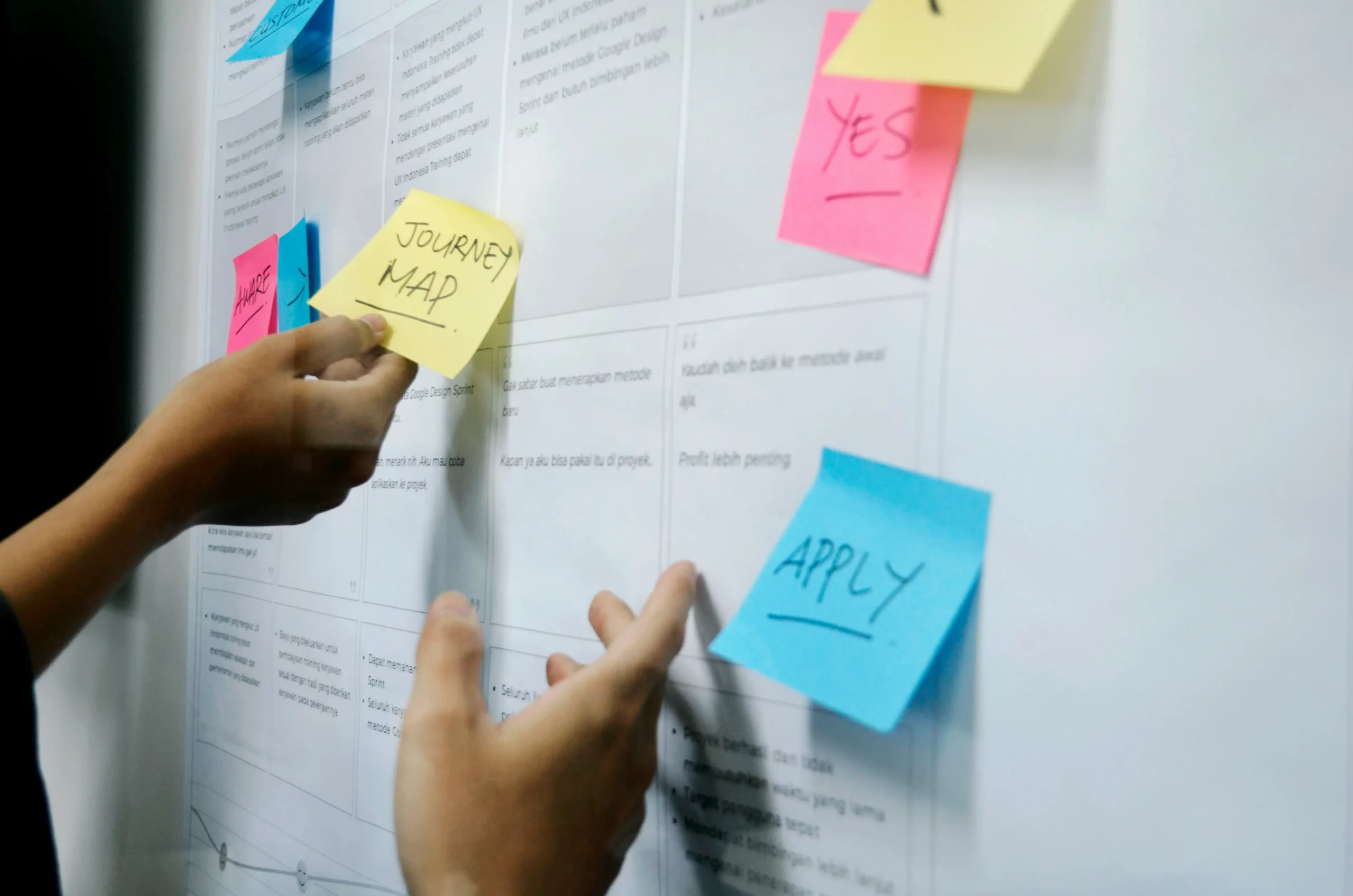Brian Verhoeven has built many design and research operations programs throughout his career. He’s led design teams of 4 designers all the way up to 130. He’s led big companies through big change.
His biggest takeaway from navigating all that change?
Involve EVERYONE in the design process.
Brian reflected on how to get the very best out of your team (and wider organization). All while expanding design’s reach and influence. He outlined five principles that have served him well during the “Life of Brian” (we couldn’t resist!):
- Establish a Design Vision
- Build Trust with All Stakeholders
- Operationalize and Streamline Design Practices
- Measure Design & Research’s Impact on Business Goals
- Be Flexible with Your Research Operations Structure

Establish a Design Vision
All design work must repeatedly circle back to the strategic organizational goals:
What is the company’s vision? What do customers want from us?
“Design often finds itself as kind of the service center to that broader initiative,” Brian said.
As a result, design leaders find themselves managing two very different stakeholders:
- Company management and team leaders – convincing them of the merits of design and how it can help them realize the company’s vision.
- Design / Research team – helping them understand how their work translates into the company’s goals.
Brian likens planning a successful design team journey to planning a family vacation. Both:
- Have a destination / vision in mind
- Make you think about what a ‘successful trip’ looks like
- Require you to pivot in the moment
Brian harked back to a family vacation in Puerto Rico. Each family member wanted to do a different activity. Some wanted to snorkel, go on jungle safari or paddle boat in the luminescent bay.
“You can rely on some of the same thinking, but you have to adapt to who your stakeholders are,” Brian said. Family members went their separate ways. They did, however, make sure to meet up and share their experiences with one another.
“It’s kind of the same thing when you’re leading a team of designers. You’re checking in with your stakeholders, your designers trying to get insights along the way. What’s working? What’s not? How do we adapt?”
Drafting Your Design Vision
Create a unique ‘design’ vision that’s aligned with the company’s organizational goals:
What does design need to do to help the company reach its vision?
At Morningstar, Brian and his colleagues wanted the company to be a great place to work for designers. They wanted to create beautiful products and services, while scaling their impact in the organization. A simple vision.
Brian warned against drafting this vision in a vacuum — it should be a collaborative effort. Involve various stakeholders and ask them to voice their thoughts and concerns. Look outside your immediate team — be more inclusive. Rope in the product team, engineering, management, go-to-market et al.
“The more people you can bring together to help you co-create the vision, the easier it will be down the line to have that influence. That buy-in of what we’re trying to do,” said Brian.
Build Trust with All Stakeholders
How do you get buy-in from everyone in a new environment?
To establish successful research and design operations, you must build trust with colleagues. It’s also easier said than done.
“There’s no one way to do that. A lot of it is not done in these big meetings. It’s done through one-on-one conversations,” he said.
Whenever Brian pivoted to a new role, he conducted one-to-one ‘listening tours’ with all his colleagues. The conversation centered around requirements and challenges in their roles. He’d ask questions like:
- What’s working for you?
- Where are you blocked?
- What help do you need?
- How would you solve this if you were in charge?
Brian made it a point to talk to EVERY stakeholder. Even unexpected ones that design doesn’t deal with on a day-to-day basis. Brian maintained constant dialogue with the procurement, finance, legal and data security teams.
Brian didn’t know that cultivating these relationships would be helpful down the line. His interactions had enabled a complete understanding of procurement processes and data security. While onboarding tools like Figma and Marvin, he was able to satisfy all stakeholders.
Brian likened the process of gathering a company’s information to a research project. Regular readers will remember that UX leaders Claire Rowell of Lattice and Gina Rahn of LINQ both suggested the same. Treating this rich information bank as an internal research project in itself. The aim?
Unearth and leverage the organization’s vast internal knowledge FIRST.
“There’s no substitute for going around and talking to people, building those relationships. That’s what a lot of work as a leader is, building relationships and trust,” Brian said.
Streamline Design and Research Operations
Brian outlined the three pillars of streamlining operations at a design practice:
Design leaders must address each factor when setting up a design team. They’re all intertwined —consider the needs of the ‘people’ while creating ‘process’ flows. ‘Tools’ must be conducive to each process and must be user-friendly.
Brian illustrated how this triad works in synchrony by sharing how the Morningstar team implemented Figma.
A change management success story
- Designers at Morningstar had been experimenting with a new tool. They alerted Brian to its benefits and potential to replace their existing software.
- Brian and his team built out a cost-benefit analysis for procurement. What was the cost of the new tool vs. the old ones?
- They alleviated any data security concerns with the relevant team. Building those relationships sure came in handy!
- The relevant decision makers approved the use of Figma. They informed the organization of the implementation of the new tool.
- Next, they had to create a process around change management. The goal was to have everyone on the same platform.
- Brian’s team created an organization-wide mandate. They communicated to the people that they had an entire year to migrate from the old tool to shiny new Figma.
- In a large organization, teams manage their own budgets. Brian’s team indicated any other tools would come out of that respective team’s budget. This motivated some teams to quickly make the switch.
- They created a process around data backup. It included guidance for designers on how to back up their old work to the company’s centralized research repository.
- It became compulsory to conduct all new work in Figma. They organized training (online & in-person) and workshops for Morningstar’s employees. This got people up to speed with the software. When people asked for training or guidance that the design team hadn’t considered, they created a training program to address that need.
- When people asked for training / guidance that the design team hadn’t considered, they created a training program to address that need.
- Brian and team sent people constant reminders of the impending shift. They increased the frequency of alerts as the deadline approached.
- With no defaulters, the entire organization had completely migrated to Figma. Great success!
The benefits of operationalizing your change workflows
Their efforts bore fruit — Figma has further enhanced Morningstar’s workflow. A single cohesive platform worked far better than the two they used before. The ease of sharing work allows for greater collaboration across the company. The ability for many hands to work on the same project has been crucial for remote collaboration. Communication has become streamlined. This has led to better alignment between designers, developers and product managers.
Productivity benefits aside, the initiative significantly reduced business expenses. Tooling costs dropped, as the company was using a singular platform. Less investment into training followed, as employees only had to learn one software. It simplified vendor management, due to less vendors there was less invoicing.
People, processes and tools dovetailing seamlessly.
Measure Impact of Design & Research on Business Goals
“If you’re not measuring design, (it’s) not a great place for designers to work because they don’t know what impact they’re having,” said Brian.
Morningstar used OKRs (objectives and key results) to gauge:
- The ‘health’ of the design team
- Impact design was having
Brian relies on a framework adapted from Abraham Maslow’s hierarchy of needs. It helps measure product quality and the impact of design and engineering:
This layered framework helped the company determine quality metrics they could measure:
- Foundational – Is the app available? Secure? Does it operate error-free?
- Functional – Must have features for customers. What tasks do they have to perform?
- Usable – Ease of use and efficiency; Brian and co. conducted usability testing using SUS to benchmark scores across all products.
- Desirable – What makes a product experience memorable and beautiful? Very difficult to measure. Brian confessed they’ve had mixed results here.
- Meaningful – What’s the significance to the end user? How does it contribute to brand loyalty (creating a moat) and high switching costs?
The framework doesn’t include business metrics such as revenue or customer satisfaction . Brian and team wanted it to be relatable to the designer or engineer carrying out work on the product.
According to Brian, designers must balance the needs of two very important stakeholders. Their customers, and the organization itself:
“Traditionally, we haven’t been good at tying our work to business outcomes. We’ve got to be able to talk business. We are here to move organizations forward. We’re here to accomplish those business goals while having an impact on our customers. Due to our empathetic nature, sometimes we over-index too much on helping the customer. We forget about the business objectives that keep us all employed. We have to marry those two better somehow,” he said.

Be Flexible with the Research Operations Organizational Structure
Brian (and his colleagues)’s vision for Morningstar didn’t waiver.
To expand design’s reach, they had to consider the processes and systems required. They periodically reviewed their tactics to see what worked and what didn’t. Sometimes, it would cause them to pivot in a new tactical direction. The end goal never changed — it was how they got there that did.
Brian shared his advice for getting the most out of your organizational structure:
Structure Teams Effectively
Streamlining the organizational structure is vital for expanding design’s reach across a company.
While scaling operations, leaders must be cognizant of the fact that every team has varying degrees of design maturity.
Brian’s not a fan of the embedded design model. That’s when a designer becomes part of another team’s (e.g. product) operations, lending a hand with the design perspective. The team is at the mercy of a sole designer. Within a large organization, one team could have a junior designer and while the other has a senior one. Their output will vary widely in quality and rigor.
How should you structure your design team?
Brian recommends aligning junior designers with design leaders who manage one customer journey. Design leaders offer a line of defensive support with continuous coaching and input.
Brian and his team chart career paths for various roles, setting clear expectations at each level. This develops designers’ competency within the org.
Learn How to Manage Change
Helping teams deal with change is the hallmark of a good leader.
Brian shared a story of a design colleague who was resistant to the Figma migration. He felt he was more efficient and better suited to the old suite. Plus with all his product work, he simply didn’t have time to learn a whole new software. But Figma was already here.
Brian helped delegate his product work away. In no time, this designer became a champion of Figma, creating libraries for everyone to use. He started giving back to the broader design community.
Brian shared great advice about what he learned from the experience:
“Shrink the change. Find a way to make that change as small as possible for everybody going through it.”
We love this — and we know change management can be hard on everyone. Twilio’s Vanessa Whatley shared her tips for managing change & building resilient teams.
Pick Your Battles
Departments within companies can operate an entirely different tool stack. The advantages of using the same tool versus several different ones are plain to see. There are financial, workflow, efficiency and environmentals savings to be had.
Should you always consolidate tools?
Begin by looking at the structure and decision-making process of the organization. In some cases it’s not possible to enforce uniformity across an organization. Brian’s advice? Don’t lose sleep over it — accept it.
“One of the things we try to do as designers is fix everything because we have a problem-solving mindset. Just let that go. That’s too much to take,” he said.
Want to learn directly from Brian’s experience scaling research operations at multiple companies? Check out the full conversation now.
Photo by UX Indonesia on Unsplash





